More than 13 million Spanish-speaking people in the U.S. are prescribed generic medications every year. But many don’t know what those pills really are. They see a different color, shape, or label and think it’s not the same medicine. That fear leads to skipped doses, worse health outcomes, and higher costs. The truth? Generic medications work exactly like brand-name drugs. They contain the same active ingredients, meet the same safety standards, and are approved by the FDA. The only real difference? Price. Generic versions often cost 80% less.
Why Spanish-Speaking Patients Struggle With Generic Medications
A 2023 survey by the California Health Care Foundation found that 63% of Spanish-speaking patients doubted whether generic drugs were as effective as brand names. Why? Because they weren’t told otherwise. Many providers assume patients understand the basics. But when a pharmacist hands over a white oval pill instead of the blue round one the patient remembers, confusion sets in. The language gap makes it worse. The word for generic medication in Spanish is medicamento genérico. But that term doesn’t carry the same weight as "FDA-approved" or "therapeutically equivalent." Without context, it just sounds like a cheaper version-like a knockoff. Patients hear "más barato" (cheaper) and think "menos efectivo" (less effective). Some patients even refuse generics because their doctor didn’t explain the switch. One patient in Texas told a nurse: "Mi doctor nunca me dijo que era lo mismo. Solo me dio otra pastilla." (My doctor never told me it was the same. He just gave me another pill.)What Spanish-Language Resources Actually Exist
There are real tools out there-good ones. But they’re scattered, underused, and not always easy to find. The Agency for Healthcare Research and Quality (AHRQ) offers a free, downloadable tool called My Medicines List in Spanish. It’s simple: a fillable form that asks patients to write down the brand name, generic name, why they take it, the dose, and how often. It’s designed for daily use, not just for doctors’ visits. Over 250,000 copies have been downloaded since its 2023 update. MedlinePlus.gov has a bilingual PDF comparing brand and generic names side by side. It includes common drugs like lisinopril (Zestril), metformin (Glucophage), and atorvastatin (Lipitor). Each entry shows both names, the condition it treats, and a note that generics are "igualmente seguras y efectivas." (equally safe and effective.) Wake AHEC, a North Carolina health education group, created a pocket-sized pharmacy translation card with phrases like:- "Esta medicina tiene una apariencia diferente, pero es lo mismo." (This medicine looks different, but it’s the same.)
- "¿Tiene la versión genérica de esa medicina? La original es muy cara." (Do you have the generic version of that medicine? The brand name is too expensive.)
What’s Missing: Regional Differences and Visual Cues
Here’s where most resources fail. In Spain, the generic version of Tylenol is called paracetamol. In Mexico, Colombia, and most of Latin America, it’s acetaminofén. Same drug. Same effect. Different word. If a patient moves from Texas to Arizona, or visits family in Puerto Rico, the name change can trigger panic. Many Spanish-language guides don’t mention this. Another big gap? Visuals. A 2022 study from the University of Miami showed that when patients saw side-by-side photos of brand and generic pills, confusion dropped by 37%. But only 1 in 5 Spanish-language materials include images. That’s a huge missed opportunity. The Medicamento Genérico app, launched by the NIH in September 2023, fixes this. It lets users take a picture of their pill, compare it to images of brand and generic versions, and hear the correct pronunciation of each name. It even has a cost calculator: "Tu medicamento de marca cuesta $120 al mes. La versión genérica cuesta $24. Ahorras $96 al mes."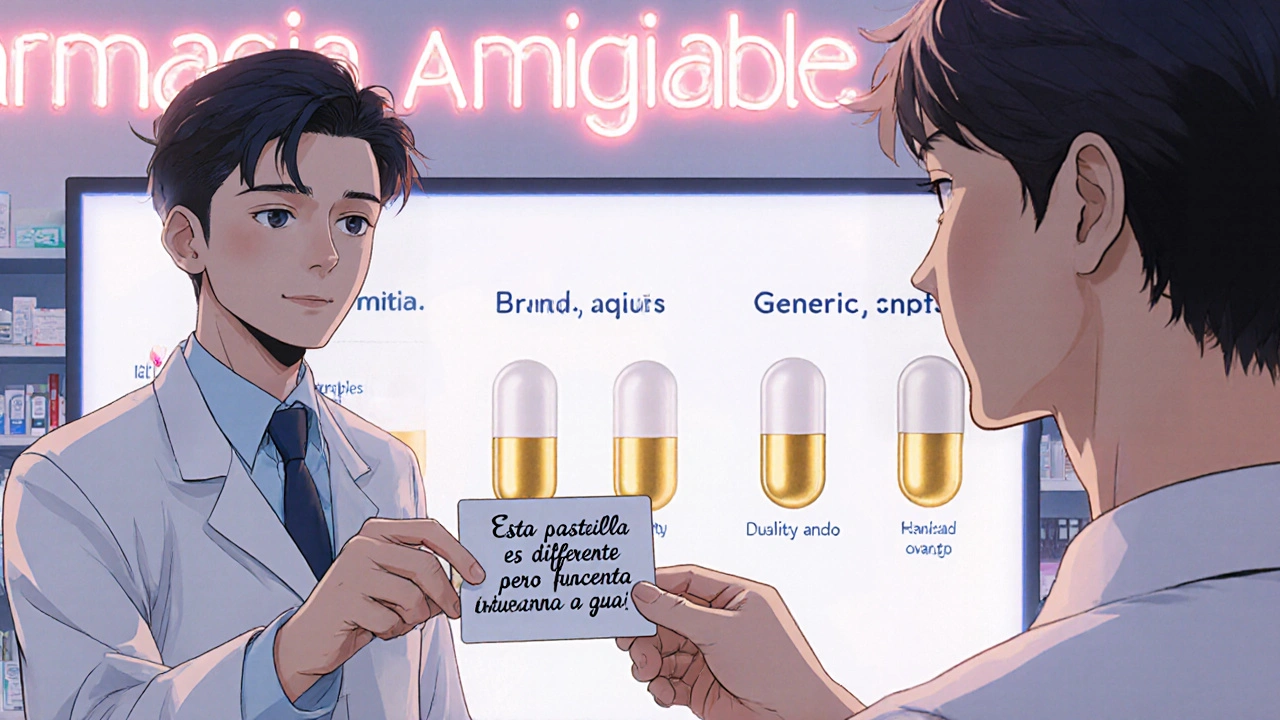
How Providers Can Use These Tools
Doctors and pharmacists aren’t expected to be fluent in Spanish. But they don’t need to be. They just need to know where to point patients. Start by asking: "¿Tiene usted un medicamento genérico disponible para esta receta?" (Do you have a generic version available for this prescription?) Then hand them the AHRQ form or the MedlinePlus PDF. Don’t assume they’ll ask questions. Most won’t-they’re afraid of sounding ignorant. Use the Wake AHEC phrases during counseling. Say: "Esta pastilla es diferente, pero funciona igual." (This pill looks different, but it works the same.) If your clinic uses electronic health records, ask if they support AI-powered translation. Kaiser Permanente’s system now auto-generates Spanish explanations based on the patient’s region. If the patient is from El Salvador, it uses Salvadoran terminology. If they’re from Miami, it uses Cuban or Puerto Rican variants.Why This Matters: Cost, Safety, and Equity
Generic medications make up 90% of all prescriptions filled in the U.S. But they account for only 22% of total drug spending. That’s over $300 billion saved every year. Yet, Spanish-speaking patients are the least likely to use them. Why? Because they’re not being told the truth. Dr. Maria Hernandez from Harvard Medical School found that bilingual medication resources reduced medication errors by 23% since 2015. But generic confusion remains one of the top three reasons patients stop taking their meds. A 2023 report from the National Hispanic Medical Association found that 68% of Spanish-speaking patients actively seek cheaper alternatives-but only 32% understand that generics are just as safe. That’s a dangerous gap. Section 1557 of the Affordable Care Act requires healthcare providers to offer language assistance. But compliance is uneven. Only 41% of community health centers have full Spanish medication resources. And only 28% explain generic equivalence clearly.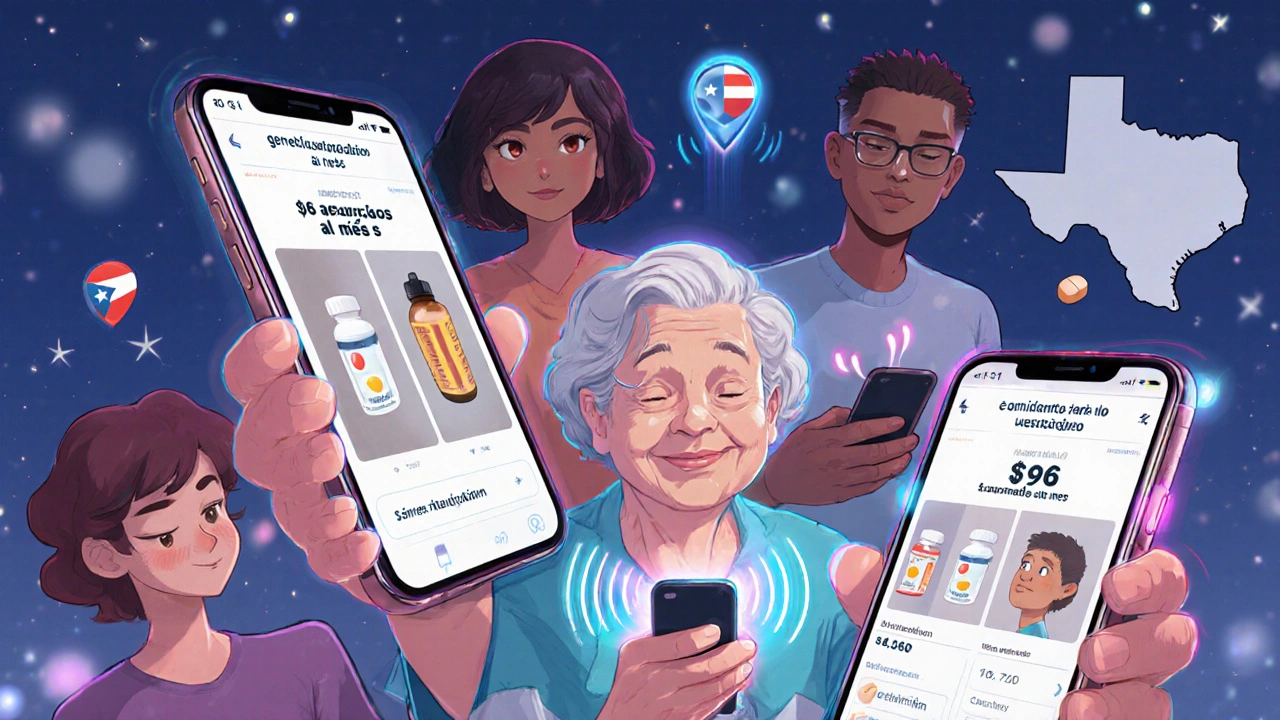
What Patients Can Do Right Now
You don’t need to wait for your doctor to give you a handout. Here’s what you can do today:- Download the My Medicines List from AHRQ.gov in Spanish. Fill it out with your current meds.
- Visit MedlinePlus.gov and search "medicamentos genéricos" for side-by-side comparisons.
- Ask your pharmacist: "¿Esta pastilla es igual que la que tomaba antes?" (Is this pill the same as the one I took before?)
- Use the Medicamento Genérico app to take a photo of your pill and compare it to images.
- Save the phrase: "La versión genérica es igual, pero más barata." (The generic version is the same, but cheaper.)
What’s Next: AI, Personalization, and Better Access
The future of Spanish-language medication education is personal. Epic Systems and other EHR platforms are testing AI tools that automatically generate Spanish explanations tailored to where a patient was born. If you grew up in Guatemala, you’ll see "acetaminofén." If you’re from Spain, you’ll see "paracetamol." Same drug. Same safety. Same result. The NIH’s app is just the beginning. More clinics are adding audio clips so patients can hear how to pronounce "farmacia," "receta," and "genérico." No more guessing. The goal isn’t just to translate words. It’s to build trust. To say: "We see you. We know you’re worried. And we’re here to help you understand."Are generic medications really the same as brand-name drugs?
Yes. Generic medications contain the same active ingredients, work the same way, and meet the same FDA safety and effectiveness standards as brand-name drugs. The only differences are the inactive ingredients (like color or shape), the brand name, and the price. Generics cost up to 80% less.
Why do generic pills look different from brand-name pills?
By law, generic pills can’t look exactly like brand-name pills. So manufacturers change the color, shape, or markings to avoid trademark issues. But the medicine inside is identical. Visual guides and apps like Medicamento Genérico show side-by-side images so patients know the difference is only in appearance.
Is "paracetamol" the same as "acetaminofén"?
Yes. "Paracetamol" is the term used in Spain and some parts of Europe. "Acetaminofén" is used in Latin America and the U.S. They are the exact same drug-the generic version of Tylenol. Regional differences in terminology are common, which is why tools now include both versions.
Where can I find free Spanish resources about generic medications?
Start with AHRQ.gov’s "My Medicines List" in Spanish, MedlinePlus.gov’s bilingual PDFs, and the free NIH "Medicamento Genérico" app. These are all official, no-cost resources designed for patients and caregivers.
What should I say to my pharmacist if I’m unsure about a generic drug?
Ask: "¿Esta medicina es igual a la que me daba antes?" (Is this medicine the same as the one I had before?) or "¿Puedo usar esta versión genérica sin problemas?" (Can I safely use this generic version?) Pharmacists are trained to explain equivalence. Don’t be afraid to ask.

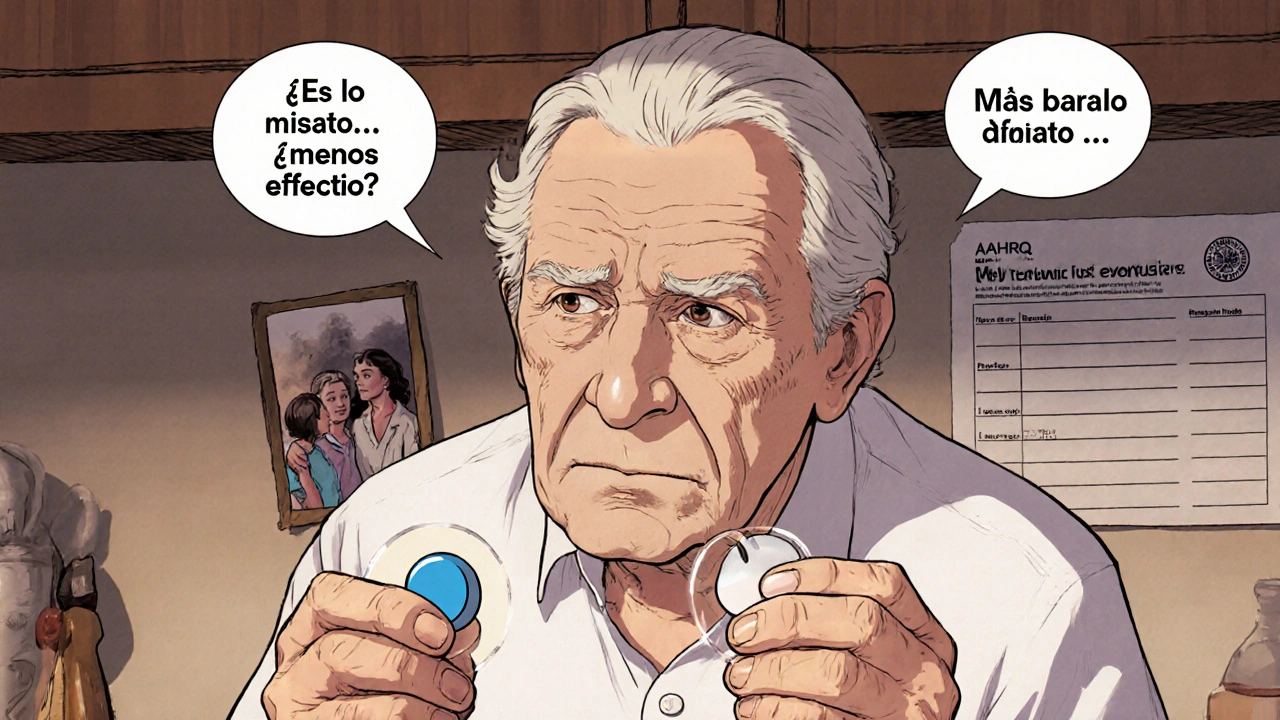
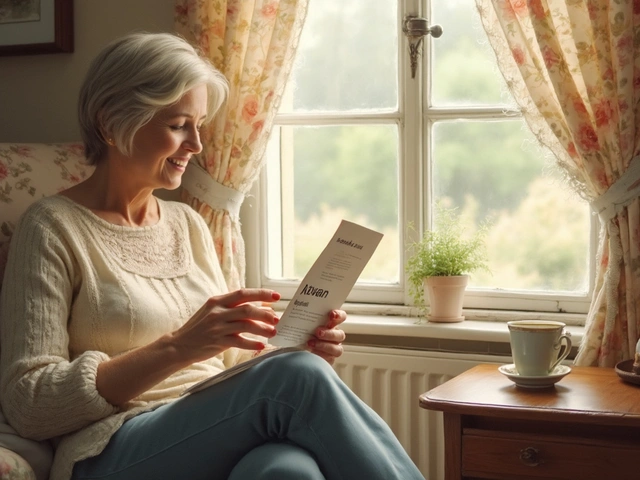


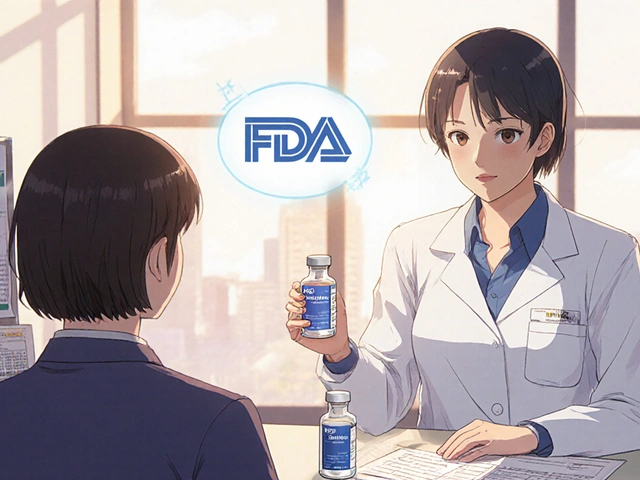
Tarryne Rolle
November 18, 2025 AT 07:49So we’re just supposed to trust that a white oval pill is magically the same as a blue round one because some bureaucrat in DC says so? What about bioavailability? What about the fillers? You think the FDA audits every single batch? This isn’t faith-it’s pharmaceutical colonialism dressed up as equity.
Kyle Swatt
November 20, 2025 AT 02:24Look I get it-people panic when their meds look different. I’ve seen grandmas cry because their Xanax switched from a little round pill to a big white one. But here’s the truth: the science ain’t lying. Same active ingredient. Same damn chemistry. The color’s just dye. The shape’s just mold. The real villain? The pharma companies that make you think you’re getting more for more money. Generics are the people’s medicine. Stop letting corporate branding fool you. I’ve been on generics for 12 years. Still alive. Still sane. Still got my damn kidneys.
Deb McLachlin
November 21, 2025 AT 04:12It is noteworthy that the disparity in comprehension regarding generic medications among Spanish-speaking populations is not merely linguistic, but also rooted in systemic gaps in health literacy infrastructure. The resources cited-AHRQ, MedlinePlus, and the NIH app-are commendable, yet their accessibility remains contingent upon digital and educational privilege. A more robust intervention would integrate these materials into community pharmacy workflows, not merely distribute them as PDFs. Translation alone is insufficient without contextual pedagogy.
saurabh lamba
November 22, 2025 AT 15:50bro why are we even talking about this? just take the cheap pill. if it works, it works. if it dont, go back to the expensive one. its not rocket science. 🤷♂️
Kiran Mandavkar
November 23, 2025 AT 04:33Oh please. You think a Spanish-speaking grandmother in El Paso knows what "therapeutically equivalent" means? You think she cares about FDA standards? This whole post reads like a corporate white paper written by someone who’s never held a pill bottle in their hand. The problem isn’t the language-it’s that the system doesn’t give a damn about her. You give her a PDF? That’s not help. That’s performance. Real equity means training bilingual pharmacists-not handing out apps like pamphlets at a charity gala.
Eric Healy
November 24, 2025 AT 12:10generic meds work fine i been on them for years no prob but why do they always make em so damn big? like why cant they make the generic lisinopril look like the brand? its the same chem but the size makes me feel like im swallowing a rock. also why do they use different colors every time? i swear my blood pressure drops just from the anxiety of not knowing what im taking
Shannon Hale
November 24, 2025 AT 15:14THIS IS WHY PEOPLE DIE. NOT FROM THE MEDS. FROM THE FEAR. FROM THE SILENCE. FROM THE DOCTORS WHO THINK "SHE’LL FIGURE IT OUT" WHEN SHE’S STARE AT A WHITE PILL AND THINKS SHE’S BEING POISONED. I’VE SEEN IT. MY ABUELA STOPPED HER BLOOD PRESSURE MEDS FOR SIX MONTHS BECAUSE THE PILLS LOOKED "WRONG." SIX MONTHS. SHE HAD A STROKE. THEY TOLD HER IT WAS "GENÉRICO." SHE THOUGHT IT MEANT "FAKE." WE DIDN’T KNOW HOW TO EXPLAIN IT. NO ONE TAUGHT US. THIS ISN’T A LOGISTICS PROBLEM. IT’S A CRIME.
Holli Yancey
November 25, 2025 AT 21:07I think the most powerful thing here is the idea that trust isn’t built through brochures-it’s built through repetition, through seeing the same phrase said calmly by someone who cares. "Esta pastilla es diferente, pero funciona igual." That line, repeated, with eye contact, with time... that’s the real medicine. The app is cool. The PDFs are helpful. But the human moment? That’s what changes behavior.
Gordon Mcdonough
November 25, 2025 AT 22:02AMERICA IS BEING DESTROYED BY THIS KIND OF PC NUTTINESS!! WHY DO WE HAVE TO MAKE PILLS FOR SPANISH PEOPLE?? CAN’T THEY JUST LEARN ENGLISH?? I PAY TAXES FOR THIS?? I’M NOT PAYING FOR A PHARMACY APP THAT TALKS TO ME IN SPANISH!! I’M NOT A MEXICAN!! I’M AN AMERICAN!! AND I WANT MY PILLS TO LOOK THE SAME!! THIS ISN’T EQUALITY-IT’S SURRENDER!!